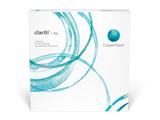
All over the world, air quality reports are often included in the day’s weather forecast—especially during the summer months, when ozone levels can spike. Although it may bother some people more than others, the eye is vulnerable to the effects of air pollution,1 which means air quality can certainly impact how comfortable your eyes feel. And, depending on how polluted the air is, it can affect your quality of life—particularly when it leads to irritation while you’re wearing your contact lenses.
Of course, there is no easy fix or overnight remedy that will repair the air outside your front door, but there are some simple strategies that can help you find relief for your eyes when air quality is at its worst.
What’s up with the air?
When scientists talk about smog and air pollution, they’re often referring to too much ozone, which seems like a contradiction. After all, ozone forms a protective layer that shields us from the sun’s harmful ultraviolet rays.2 In other words, ozone is a good thing, right? Yes and no. Ozone can be good or bad, depending on where it is found.2
Ozone is an odorless, colorless gas that occurs both in the Earth’s upper atmosphere and at ground level.2 In the Earth’s lower atmosphere, near ground level, ozone is not formed naturally. Rather, it is formed when pollutants emitted by cars, power plants, industrial boilers, refineries, chemical plants, and other sources react chemically in the presence of sunlight.2 This ground-level or "bad" ozone is a harmful air pollutant and a main ingredient of urban smog.3
When ozone levels are very high, everyone should be concerned about ozone exposure.2 Ozone pollution is a big concern during the summer months because strong sunlight and hot weather result in harmful ozone concentrations.3
How to shield your eyes
We often hear about how pollution affects breathing, but the lungs aren’t the only part of your body that feels the effects of bad air quality. The eye is vulnerable to the effects of air pollution too.1 Manifestations of air pollution can range from minimal or no symptoms to chronic discomfort and eye irritation.1 And, if you are a contact lens wearer, your eyes may be adversely affected by air pollution,1 which can significantly affect your quality of life if you’re not comfortable and need to wear glasses instead.
If your eyes are uncomfortable, talk to your eye doctor. A combination of rewetting drops and, in some cases, a different contact lens may help. For example, your doctor may recommend a 1 Day lens. By putting a fresh pair of lenses on every day, you can rest assured that no deposits are left behind from the day before. CooperVision offers a diverse range of 1 Day lenses, including the MyDay® lens, which is made of silicone hydrogel—the most breathable, healthiest1 soft contact lens material that keeps eyes white and bright.2
References
1. Klopfer J. Effects of environmental air pollution on the eye. J Am Optom Assoc. 1989 Oct;60(10):773-8.
2. United States Environmental Protection Agency. Smog—Who Does It Hurt? July 1999. Available at: https://www3.epa.gov/airnow/health/smog.pdf
3. United States Environmental Protection Agency. Ozone: Good Up High, Bad Nearby. Available at: https://www3.epa.gov/airnow/gooduphigh/ozone.pdf
1With higher oxygen permeability than hydrogel materials, silicone hydrogel contact lenses minimize or eliminate hypoxia-related signs and symptoms during lens wear.
2High oxygen transmissibility promotes clear, white eye
Nothing in this blog post is to be construed as medical advice, nor is it intended to replace the recommendations of a medical professional. For specific questions, please see your eye care practitioner.





